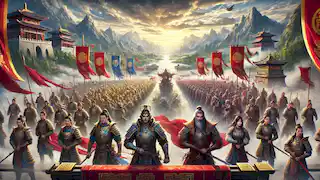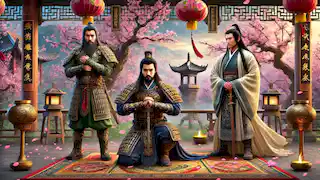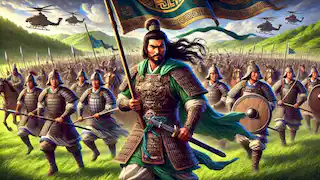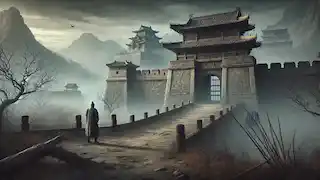The Legend of the War of the Three Kingdoms
Reading Time: 8 min

About Story: The Legend of the War of the Three Kingdoms is a Legend from china set in the Ancient. This Dramatic tale explores themes of Courage and is suitable for Young. It offers Historical insights. An epic tale of war, loyalty, and ambition that shaped ancient China.
The story of the Three Kingdoms era in China, filled with legendary battles, strategic brilliance, and the fierce loyalty of warlords and generals, remains one of the most epic tales in the annals of history. Set during the twilight of the Eastern Han Dynasty, this turbulent period saw the rise of three powerful states—Wei, Shu, and Wu—each led by a charismatic ruler, vying for supremacy over the vast Chinese territories. It was an age marked by cunning tactics, mighty warriors, and alliances forged and broken in the fires of war.
As the Han Dynasty crumbled, chaos spread across the land, and powerful figures emerged to seize power, ushering in the era of the Three Kingdoms. From the loyalty of the famed generals to the ruthlessness of ambition-driven rulers, this story captures the essence of an epoch where honor, betrayal, and bravery determined the fates of men and empires alike. The Eastern Han Dynasty had ruled China for centuries, but by the late 2nd century AD, corruption and internal conflicts had weakened its foundation. Emperor Ling of Han was heavily influenced by the eunuchs within his court, who abused their power, imposing burdensome taxes upon the people and plunging the empire into poverty and despair. Discontent spread like wildfire across the empire, and rebellions began to flare up in the form of the Yellow Turban Rebellion. Led by Zhang Jue, the Yellow Turban rebels were a force of farmers and peasants who rallied under the banner of “Heaven's Mandate,” advocating for a new era. This rebellion exposed the incompetence of the Han military, and in response, powerful warlords were commissioned to suppress the uprising, marking the beginning of the era’s power struggle. Among these warlords were ambitious men whose eyes were set beyond mere quelling of the rebellion. Men like Cao Cao, a brilliant strategist and ambitious leader; Liu Bei, a man of noble heart and lineage; and Sun Jian, a fiery warrior from the southern lands, emerged as key figures destined to shape China’s future. As they crushed the rebellion, their armies swelled, and they began to stake their claims over the fractured empire. Cao Cao, a shrewd warlord with unmatched tactical prowess, quickly established himself as a formidable power in the north. His charisma attracted thousands of men to his ranks, including famed generals and advisors. Cao Cao’s ambition was clear—he intended to unify China under his rule. However, his ascent was not without opposition. Rival warlords saw him as a threat, especially Yuan Shao, an aristocrat with a strong army who sought to bring Cao Cao down. The Battle of Guandu was a defining moment for Cao Cao. Despite being vastly outnumbered, he used clever tactics to break Yuan Shao’s forces, solidifying his control over northern China. Cao Cao’s strength lay not only in his strategic mind but also in his ability to inspire loyalty among his men. His trusted generals, including the fierce Xu Chu and the wise Guo Jia, helped him overcome insurmountable odds. With each victory, Cao Cao’s dream of uniting China grew closer. While Cao Cao gathered power in the north, a very different leader was emerging in the western lands. Liu Bei, a man of humble origins but with a heart that burned with loyalty to the Han Dynasty, was regarded by many as a true son of heaven. He formed a brotherhood with two legendary warriors, Guan Yu and Zhang Fei, pledging to restore peace to the land and defend the Han lineage. Liu Bei’s loyalty to the people earned him the respect and support of the common folk, who saw him as a beacon of hope amidst the chaos. Guan Yu, known for his valor and unwavering loyalty, and Zhang Fei, renowned for his strength and bravery, became Liu Bei’s closest allies. The three men, bound by a sacred oath, sought to create a just kingdom, though they faced countless obstacles. Their brotherhood was tested as they ventured through the war-torn lands, fighting to defend the people and resisting the growing power of Cao Cao. Though Liu Bei’s forces were small, his sincerity and just nature attracted skilled warriors and strategists who shared his vision. Meanwhile, in the south, a fierce warrior named Sun Jian rose to power. Known as the “Tiger of Jiangdong,” Sun Jian was fearless in battle and highly skilled with a sword. His family would later establish the Kingdom of Wu, a powerful state that would play a pivotal role in the Three Kingdoms era. Sun Jian’s sons, Sun Ce and Sun Quan, inherited his warrior spirit. Sun Ce, the elder of the two, was known for his reckless bravery, while Sun Quan was calm, thoughtful, and an excellent administrator. After Sun Jian’s death, his sons carried on his legacy, building a prosperous and powerful state along the Yangtze River. Wu became a bastion of strength and resilience, and under Sun Quan’s leadership, it transformed into a well-organized kingdom with a formidable navy. As the power dynamics shifted, the three kingdoms of Wei, Shu, and Wu found themselves on a collision course that would lead to one of the most famous battles in Chinese history—the Battle of Red Cliffs. Cao Cao, having conquered much of the north, set his sights on the south, intending to bring the entire country under his rule. With a massive army and fleet, Cao Cao advanced toward the Yangtze River. Realizing the threat, Liu Bei and Sun Quan formed a temporary alliance, understanding that neither could withstand Cao Cao’s power alone. They combined their forces and prepared for a decisive battle at Red Cliffs, on the banks of the Yangtze. The young and brilliant strategist Zhuge Liang, who served Liu Bei, alongside Sun Quan’s strategist Zhou Yu, devised a plan to use fire to devastate Cao Cao’s fleet. As the night fell, Wu and Shu forces set Cao Cao’s ships ablaze, causing chaos among his troops. Cao Cao’s forces were routed, and his ambition of uniting China under his rule was thwarted, at least for a time. Following the victory at Red Cliffs, the three kingdoms formally took shape. Cao Cao declared himself the ruler of Wei in the north, while Liu Bei took control of Shu in the west, and Sun Quan solidified Wu in the south. China was officially divided, and the ensuing years saw countless skirmishes, betrayals, and alliances as each kingdom vied for dominance. Liu Bei, bolstered by Zhuge Liang’s wisdom and the bravery of Guan Yu and Zhang Fei, attempted to expand Shu’s territory, believing it was his divine right to restore the Han Dynasty. His ambitions were noble, but he faced stiff resistance from both Wei and Wu. The Three Kingdoms era was a time of shifting loyalties. Allies could quickly become enemies, and even family bonds were not immune to the lure of power. Guan Yu’s death at the hands of Sun Quan’s forces was a blow to Liu Bei, who, in his grief and anger, led a futile campaign against Wu, which ultimately weakened Shu. Zhuge Liang, Liu Bei’s trusted advisor, was known as a sage of unparalleled wisdom. After Liu Bei’s death, Zhuge Liang took on the burden of fulfilling his master’s dream of restoring the Han Dynasty. He launched a series of northern campaigns against Wei, determined to honor Liu Bei’s legacy. Though his strategies were ingenious, Zhuge Liang’s campaigns ultimately failed. Wei’s defenses were strong, and despite his best efforts, Zhuge Liang was unable to secure victory. His health deteriorated due to the stress of constant warfare, and he passed away during his final campaign, leaving Shu weakened and vulnerable. With Zhuge Liang’s death, Shu struggled to maintain its power. Cao Wei, now under the leadership of Sima Yi and his descendants, grew stronger, consolidating power and crushing opposition. Wu, too, began to decline as internal conflicts weakened its stability. Finally, in 280 AD, after decades of warfare and bloodshed, the Jin Dynasty, founded by the descendants of Sima Yi, conquered Wu, bringing an end to the Three Kingdoms era. China was once again unified, but the legends and stories of the Three Kingdoms would live on, inspiring future generations with tales of loyalty, heroism, and sacrifice. The Three Kingdoms era may have ended centuries ago, but its impact on Chinese culture and history is profound. The characters of this turbulent time—Cao Cao, Liu Bei, Sun Quan, Zhuge Liang, Guan Yu, and others—have become symbols of various virtues and vices. Their lives, filled with ambition, loyalty, betrayal, and heroism, continue to resonate in literature, art, and folklore. “The Romance of the Three Kingdoms,” a historical novel written by Luo Guanzhong, immortalized these figures and events, blending history with legend and bringing their stories to life. To this day, the Three Kingdoms period is celebrated and studied, a testament to a time when the fate of China was shaped by the actions of a few remarkable individuals.The Fall of the Han Dynasty
The Rise of Cao Cao
The Brotherhood of the Peach Garden

Sun Jian and the Rise of Wu

The Battle of Red Cliffs

The Establishment of the Three Kingdoms
The Wisdom of Zhuge Liang
The Decline and Fall

Epilogue: Legacy of the Three Kingdoms

















